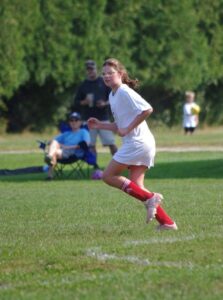McKenna is our first born. My pregnancy with her was normal, but her delivery was difficult. She had shoulder dystocia and required intervention to be born. We were moments away from an emergency c-section. Despite all of this, she had great Apgar scores and all seemed ok.
Being my first baby, nursing was a steeper learning curve for me. McKenna did not take to nursing right away and it was difficult to get her to eat as she wasn’t getting anything until my milk came in. Once we finally got the hang of nursing, she did not self-regulate like I had been told most babies would. Again, just chalked it up to us both being new at this and me not being able to read cues.
Fast forward to age 2, McKenna’s little sister, Emily, was born. We realized McKenna had very few words and approached her pediatrician who referred us to early intervention. From ages 2-3 we spent a lot of time with an OT, SLP and Developmental Educator exploring what could be causing her speech and other issues. McKenna was also very prone to tripping and falling and drooled A LOT – all attributed to a weak core and issues with her muscle tone. Simultaneously, we had her evaluated by the Child Development Clinic (CDC). The CDC, after several evaluations and meetings, determined that she had a general processing disorder, developmental delays and speech delays. We were referred to the genetics team at the UVM Medical Center Children’s Hospital. At that time because she was physically healthy and her symptoms seemed to be something developmental that she might outgrow, we did not have her genetically tested. The CDC also referred us to a psychiatrist to evaluate her anxiety. At age 3 she was also diagnosed with severe general and social anxiety, and was prescribed a low-dose of Zoloft, which went against the doctor’s usual protocol for children that young. It was not an easy decision to medicate our 3 year old, but we were out of other options and it was amazing how much of a difference it made. We didn’t realize how closed off she was even around us until she started the medication. In addition to all of these other evaluations, she was also referred to an ophthalmologist and audiologist. Her hearing tested perfectly, but her vision is impaired as she is severely far-sighted. She has been in glasses since age 3.
McKenna had a history of “shutting down” when placed in high-demand situations. So when put on the spot or asked to directly identify something, etc. she would freeze, become mute and not participate. Her early years in school were challenging because she still had limited language and we were still working on managing her anxiety. We explored a lot of evaluations with her team to gather as much information as possible to figure out how best to help her.
We were very, very blessed with an incredible team of educators and interventionists working with her all along, from the early intervention services, to her EEE Pre-School team to her K-3 team, up to now with her 4-5 team.
With her latest Special Education Evaluation through school, she was screened again for Autism Spectrum Disorder and we also opted for genetic testing as she is an anomaly in our family. Our other three children are all neurotypical with no speech, vision, or learning issues. The Autism screening ruled out ASD and the evaluator felt that the traits that lead the team to question ASD were rooted in her anxiety. The genetic testing revealed her STAG-1 mutation. I’m grateful we waited to do the testing as it is likely that the STAG-1 mutation would not have shown up when she was 3 as it is our understanding that this mutation is more recently discovered.
Now, at age 11, McKenna still struggles with speech and has educational difficulties. It is anticipated that at her next Special Education Evaluation in a year she will likely qualify for special ed based on cognitive impairment as the gap between McKenna and her peers is widening. She is mainly in a mainstream classroom without a 1:1 aid, but she is pulled for special education services and has the help of the classroom para to help her complete her work. Socially, things have become more challenging as she is now aware of her differences as are her peers and it is difficult for her to build social connections with people her own age. Despite all of this, school is still her favorite place to be.
Getting the STAG-1 diagnosis, while there is still so much unknown about exactly what this means, it answered so many questions, like her feeding issues as an infant. It also connected us to a community of families who have similar experiences after 11 years of navigating this path alone without anyone else who understands at all what it means to have a child who is a mystery to the experts and who doesn’t fit into any other box that come with a support system.


